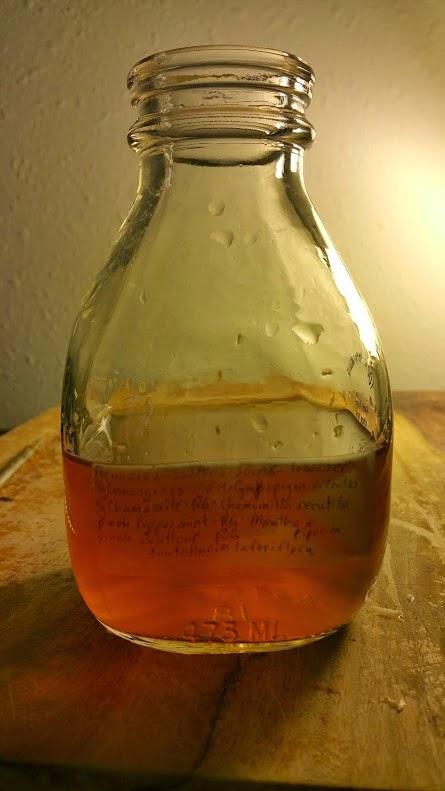Calendula-infused oil Disadvantage: It’s messy.
Calendula-infused oil Advantage: It is so pretty and can be made into an
ointment for dry skin and wounds (Chevallier, 2000). I am going to make mine into a pretty orange lip balm to replace my ever-favorite "OH! ORANGE!" Maybelline Baby Lips.
Calendula officinalis is rich in triterpenes, resins, bitter glycosides, volatile oil, phytosterols, flavonoids, mucilage, and carotones (Chevallier, 2000). So what? "What does it do?" you might ask. Calendula's actions are anti-inflammatory, relieve muscle spasms, astringent, prevent hemorrhaging, heal wounds, antiseptic, detoxifying, and mildly estrogenic (Chevallier, 2000). Quite a few of these actions make it a great choice for a salve, or in my case, lip balm - lucky for me, it's orange. In case you're horrified at the thought of an orange colored lip balm, have no fear: It might sound scary, but when it's applied to the lips, it's exquisite.
Calendula officinalis is rich in triterpenes, resins, bitter glycosides, volatile oil, phytosterols, flavonoids, mucilage, and carotones (Chevallier, 2000). So what? "What does it do?" you might ask. Calendula's actions are anti-inflammatory, relieve muscle spasms, astringent, prevent hemorrhaging, heal wounds, antiseptic, detoxifying, and mildly estrogenic (Chevallier, 2000). Quite a few of these actions make it a great choice for a salve, or in my case, lip balm - lucky for me, it's orange. In case you're horrified at the thought of an orange colored lip balm, have no fear: It might sound scary, but when it's applied to the lips, it's exquisite.
As I begin to write this portion of the post, my Calendula (Calendula
oficinalis) infusion is brewing.
My plan is to make a triple infusion to saturate the oil with robust orangeness. In a
few hours, after the Calendula and oil have infused, I will remove the flowers
from the oil and repeat the following process two more times.
***Ideally for this process, I would’ve used a crockpot with a
dimmer switch to keep the temperature between 100 and 120 degrees. I’ve
enlisted someone to rig the contraption for me, but alas, I will not be seeing
this individual for possibly another week.***
The method I am using to infuse my Calendula oil is from
Andrew Chevallier’s Encyclopedia of Herbal Medicine (2000). On page 294,
he describes the process for hot infused oils, which I will walk you through
with my pictures.
For the infusion, I am measuring a ratio of 1g herb: 5mL
oil. I measured out 5g of Calendula to be mixed with 25mL of Olive
oil.
I used my little hand crank sifter to process the flowers.
It was fun, but I think next time, I’ll bust out my coffee
grinder for greater efficiency.
5mg processed Calendula flowers, ready to go!
I looked at my graduated cylinder and realized how little
product I’d end up with if I only used 25mL of Olive oil. I ended up
going back and measuring 5 more grams of Calendula and reprocessed.
I feel like 50 mL of Olive oil is an acceptable amount for
this process.
I poured the oil onto the processed Calendula flowers and
mixed them up.
Somehow, I expected my Calendula flower bits to be swimming
around in the oil. I wonder if this thick, paste-like mixture has
anything to do with the fact that my Olive oil looks like the consistency of
soft butter. It is pretty cold in here, after all.
I’ve brought the water in my double-boiler to a boil
Then I brought it down to a simmer.
One more look at the pretty mix before the big change:
Since I am not pouring my mixture straight into the
double-boiler, I am placing my Calendula and Olive oil jar in the steam basket
over the simmering water.
Two hours later…
With a rubber scraper, I scraped out the oil and flowers into a potato ricer to push the oil out into a measuring cup.
I ended up with 31.5 mL oil.
Because I’ve decided to infuse this oil two more times, I am
topping off this infusion with enough Olive oil to restore the volume to 50
mLs. I am weighing out 10 more grams of
Calendula and repeating the process. Stay tuned.
Chevallier, A. (2000). Hot Oil Infusions. In Encyclopedia
of Herbal Medicine (p. 294). London: Dorling Kindersley.




















